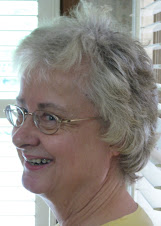Amount woven to date: 2 yards + 14"
First, I want to thank Karren for her helpful comment on badly wound pirns:
"...I...rewind badly wound pirns...onto another pirn. No loss of yarn. I usually had to increase the winding tension a bit, a 5 min. fix to an annoying distraction."
Such a simple solution. How could I not have seen it!!! Thank you, Karren. By the way, the reason for increasing the tension on the rewinding is, I assume, to enable the yarn to wind onto the new pirn without the jerking caused by the bad winding.
On an earlier post I quoted Robert Genn as follows:
"Learn to be your own best counsel and private advocate."
And he has also said this in another piece he wrote for his email newsletter:
"Learn to be alone and to be your own best critic."
(To read the entire essay where he made this last statement, go here.)
Sitting at the loom day by day, throwing the shuttle, watching carefully, tends to lead me to be
 critical of the design I am weaving. Basically, I feel happy about it, but there is something that niggles at me---the blue warp stripes. I had hoped that they would have been less dominant, blurred more than they are by the crossing weft threads. That is one of the reasons I chose a lighter blue for one of the weft threads instead of the more medium blue of the warp. The areas I like the best are when the blues are only 2-4 warp ends wide.
critical of the design I am weaving. Basically, I feel happy about it, but there is something that niggles at me---the blue warp stripes. I had hoped that they would have been less dominant, blurred more than they are by the crossing weft threads. That is one of the reasons I chose a lighter blue for one of the weft threads instead of the more medium blue of the warp. The areas I like the best are when the blues are only 2-4 warp ends wide.The photo on the left shows the blues as more muted than they really are so it does not seem to present so much the problem I am talking about. In truth, the photo is closer to what I would actually like to see on the loom than what is on the loom!
I wonder if in part what I see in the image is more like what I would see standing at a distance from the cloth. Weaving fabric is very tricky because ultimately it will be seen, and should be readable from, widely varying distances.
However, were I to make this warp again, I would design the layout of the three colors, without the blue, much as I did here. Then I would interpolate bits of blue, sometimes for only one warp end, sometimes for two, and sometimes for three, four or even maybe five. The emphasis, however, always would be on the smaller number.
Winding an odd number of warp ends creates a slight difficulty, as I would have to tie it either onto the board or onto the preceding warp end on one side. I couldn't just wind it up, and then down, and then wind it around the last peg awaiting for its next turn. But heck, there is already so much fiddling and tinkering, why not a bit more?!
One of the things that intrigues me is standing at the side of the loom, a little away from it, and
 looking at the woven fabric sideways. Standing there I can see a kind of a glittering optical illusion of a pattern. It is interesting, that this is more visible in the picture at the left which is taken from the front of the loom! This must have something to do with the built-in flash.
looking at the woven fabric sideways. Standing there I can see a kind of a glittering optical illusion of a pattern. It is interesting, that this is more visible in the picture at the left which is taken from the front of the loom! This must have something to do with the built-in flash.In any case, what is visible is the underlying structural pattern. It is even more visible in real life when I stand at the side of the loom. This pattern is otherwise pretty well hidden by the interplay of colors. But I think this effect is pretty neat. I wonder if it will be lost completely when I cut up the cloth and sew it into a garment.



1 comment:
To me, this is exciting part about weaving. It always seems to be a surprise when the weaving actually begins. So are you going to tie on another warp after this, and do as you say with the blue???
Post a Comment